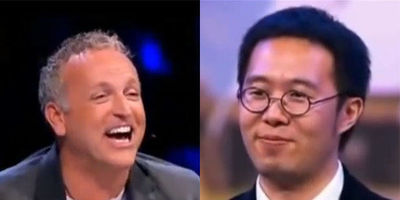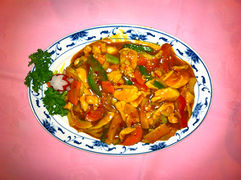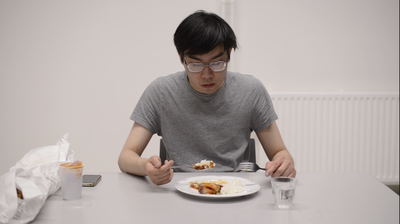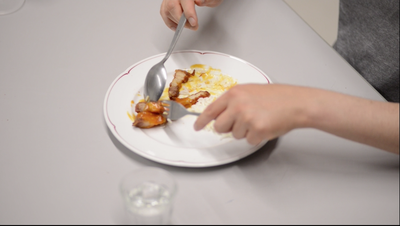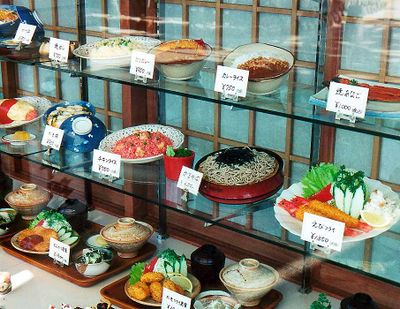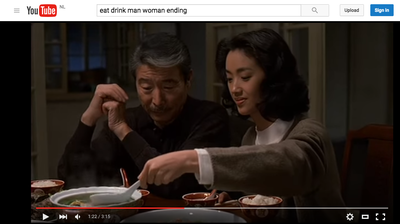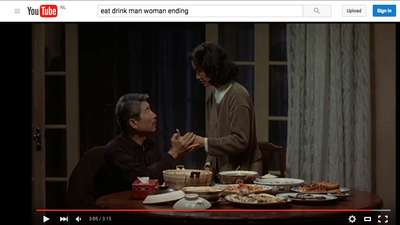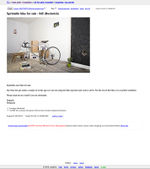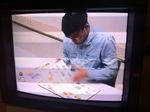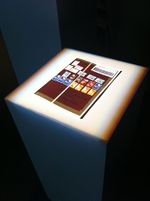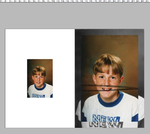User:10000BL/Project Proposalv3
TITLE: Nr. 39 with Rice
FOOD FOOD FOOD IT BRINGS US TOGETHER
INTRODUCTION
For my graduation I want to continue with a project which I initiated last year. My project Nr. 39 with Rice is at first hand a response to an event that happened during an episode of Holland Got Talent in 2013. A second angle would be the sentence Nr. 39 with Rice itself. This holds a certain richness that I want to explore.
In my project I want to present a scope of works ranging from photos, videos, interviews to installation based works.
Holland Got Talent - What happened
During an episode of Holland Got Talent in 2013 Chinese contestant Xiao Wang was asked by jury member Gordon, a Dutch singer and TV-personality, if he is going to perform the song 'Number 39 with Rice’. Gordon’s question is a reference to the extensive menus Chinese restaurants often have. The dishes on the Chinese menus can be difficult to pronounce by people not familiar with the Chinese language. To prevent miscommunications a customer often says the number of the dish when ordering food. On the contrary, to order food by its number says maybe something about the position the food takes in our society. When we consider Chinese food we see it as something easy and that it comes in high quantity for a low price.
The event from Holland Got Talent is an interesting case. It yielded debate about racism and the position of Chinese people in the Netherlands. It was covered by the established media nationally and internationally (e.g. television and newspapers) and vlogs appeared on popular media like Youtube. Last, (part of) the Chinese community responded with a website that promoted an allowance by offering 39% discount for the Nr. 39 dish in 39 restaurants all around the country.
Positioning
I’m born out of Chinese immigrants who came here with the hope to get a better life. My father used to be a chef and owned together with my mother a Chinese restaurant. The event from Holland Got Talent can be perceived as an indirect assault on my parents and my roots. Yet with the knowledge that I’m raised by Dutch people the first 12 years of my life the event gets another perspective. I look like a Chinese, but culturally and in the way I think I feel more associated towards Dutch society than the Chinese community.
POSSIBLE OUTCOMES
The sentence ‘Nr. 39 with Rice’ is I believe an interesting point of departure. The outcomes I propose encompasses literally the number 39, highlight possibly the underlying feelings of the Chinese community in the Netherlands and last show a personal relationship between a father and his son.
Outcomes according to the number 39
Photo series of number 39
For this work I visit Chinese restaurants who serve a number 39-dish. I order the dish and take a photo from a helicopter perspective of its appearance. If manageable I want to make 39 different pictures of the 39-dish.
For an exhibition I either want to frame the photos or plasticise them, like the menus you sometimes encounter in Chinese restaurants.
Mukbang number 39
Mukbang is a type of performance in which someone eats large quantities of food, while interacting with their audience for apparent entertainment value. Mukbang originated in South Korea and is spreading gradually through different types of media.
In my version of Mukbang the emphasis lies on the consumption of the food only. The interactive component of Mukbang is not part in my version. As far as I see now this branch of the project will be performed in the same restaurants I visit for the photo serie of Nr. 39. The aim is not to have the same amount of videos as in photos. Instead my target is to have about 3 to 5 videos.
In an exhibition I want to have 3-5 equally sized televisions lined up in a row. Each television is showing one of the videos. They are played simultaneously.
A cabinet of Nr. 39
This idea is in a premature state, but this work consists of plastic 3D-models (1:1) of the food I consumed in the restaurants. For this work I got inspired by plastic versions of food I see when I’m in Hong Kong, the city where my roots lie.
Hong Kong holds a culture of eating outside. To comply to this there are many small diners and restaurants all around. Next to the usual strategies of luring people into their eateries, like neon signs and displays of the menu outside, it is also common to see plastic models of the food they offer. These models come often vibrant colours. They are usually placed in a cabinet at the entrance of the eatery.
My models are either a copy or an interpretation of the food I consumed. For the exhibition i would like to have a glass cabinet that show all the models, together with a little card that displays the name of the dish, how much I liked it and the price i paid for it.
A cabinet of real Nr. 39
In response to the ‘plastic’ cabinet I want to give vistors of the exhibition the chance to eat a real Nr. 39. To do that I want to ask Chinese take-away restaurants to deliver their Nr. 39 to the address of the exhibition. When arrived the dish is placed on a table. Visitors need to unpack and help themselves if they want to eat.
Outcomes according to the Chinese community
It is unclear at the moment what the form of the works will be. My intend is to look for the people directly involved or affected. People that might be interesting for my project are restaurant owners, chefs and supporting staf.
Outcomes according to the collaboration with my father
As mentioned earlier my father use to be a chef. In his late adolescent he became responsible for his family and started his career as a chef. He ended up working as a chef in Spain and when he met my mother he moved to her in The Netherlands. The first few years he worked in the restaurant of his father in law. After a few years he and my mother started their own restaurant in The Hague. I possess fun and warm memories to that place. The restaurant's main focus lay on take-aways, but they did had a few tables for people to sit at. The menu was extensive and contained at least over 100 dishes.
My father is out of the business for more than 10 years now, but my graduation I want to ask him to go back to a restaurant and cook. The final work will ideally be a video in which my father is cooking a Nr. 39 from beginning to end. The shots of the video will mainly be details of him cutting and preparing the food. The video ends when he place the food on a plate.
At this moment I’m not quite sure to which extend I want to show my dad other than his hands preparing food. I do want to give him a voice by letting him talk about the things he is doing. The form, voice-over or live, has to be decided yet. What I do know is that father will speak in Cantonese, his mother tongue, for the sole reason that he is not fluent in either Dutch or English. The video of my father will be subtitled in English.
Juxtaposed I will be filmed and interviewed as well. The place for the interview is the dining hall of the chosen restaurant. What the interview will be, is not sure yet, but it is likely that I will talk about my father and the things he is doing in the kitchen. My interview will be in Dutch. My video will as well be subtitled in English.
The video ends when A) the dish my father prepared is served to me or B) when I finish eating the food in the restaurant. To present the work I’m thinking of merging the two videos into one cut. A second option is to keep them separate and present them next to each other on two televisions.
Considerations
- This idea only stands when I have the support and commitment from my father. My parents don’t possess a restaurant anymore, neither do any of my aunts or uncles. For me it is important that shooting takes place in a restaurant. I want to see and feel the atmosphere of the restaurant and explore if this affects my father and/or me. My parents could help me find a restaurant.
- The biggest challenge is to convince my father to participate. I don’t know how he feels to be on camera and second if he would like to cook in a restaurant. I find it plausible he only agrees to participate when the video is made at home.
- To make both videos a success I need a team with specific qualities. Since I’m not fluent in Cantonese I can't interview my father myself. It is important is to have somebody who is fluent in Cantonese and Dutch.
- I need to write a clear script. If I want to talk about what my father is doing in the kitchen, I can't film him prior to my interview. Yet in my video I want my father to present the food. As it is now, the ending of my video is made after the realisation of my father's video.
- Important is that the work with my father stays part of the project Nr. 39 with Rice. My history with my parents is turbulent and I can imagine that the work with my father can be a project on itself (where I for example explore family ties and cultural differences). I don’t want the project to focus on a parent-child relationship. What I do want is to include a certain ambivalence and uncertainty in the work. It is up to the audience to make assumptions and conclusions.
RELATION TO A LARGER CONTEXT
Countries are invented by humans. Countries work to help us frame the things we have in common whether or not influenced by natural boundaries. We created borders to discriminate and define us from the things at the other side. Throughout time borders never proofed to be something stable or save. War, natural disasters and economic and political instability led to changes in borders. Borders were also breached because countries decided to merge or form alliances.
Another cause that leads to the breach of borders is the migration of people. Migration takes place for several reasons and as a result it changes the immigrants. Refugees become citizen and receive the same rights as natives. As a result the new citizens are looking for ways to define themselves. On one had the try to merge with the new society they belong too, on the other hand they try to preserve their cultural background and sometimes this clashes.
PRACTICAL STEPS
At this moment I find it difficult to relate my project to a larger context. The ideas I have for the works are fresh, yet excites me. In most of the works I'm in control. The work in which I think I'm not in control is the work with my father. I see a lot of bumps on the road in the realisation of this particular work. For the development of Nr. 39 with Rice i think it is important to start investigating the work with my father. From there on I can define and organise the other works i have in mind.
I need to keep in mind that I don't want the work with my father to take over the the project. It is an investigation around Nr. 39. It is not a project where I explore father-son relationships.
THESIS INTENTION & REFERENCES
Subject of the thesis can be the meaning and bonding of food in Chinese culture and how this is cultivated in Dutch society.
An interesting reference is the film Eat, Man, Drink, Woman (1994) directed by Ang Lee. The movie shows a family that struggles within and in interactions with others. Yet their love for food, brings back together the remaining father and daughter.
The book Oostenwind (2010) by Karina Meeuwse gives an insight in how the Chinese community in the Netherlands developed. It explains partially my own background.
RELATION TO PREVIOUS PRACTICE
Working on or around online platforms, collecting data and making collections comes back in several other works I made or are working on.
TE KOOP
In my project TE KOOP I infiltrate online commodity markets e.g. Craigslist and Marktplaats. In TE KOOP I make photos of a furnitures or bikes in household settings. Each photo combined with a short description is turned in an advertisement and posted on several commodity markets around the world. The advertisements function as bait and elicit responses. Most responses are about the items offered. I answer the questions raised and try to start conversations with the respondents. In 95% of the cases the conversations stays around the product I seemingly offer. In some cases the conversations transform into an almost friendly conversation.
In TE KOOP both the photos and conversations are equally important, the photos of the items don’t exist without the online content generated and visa versa. The conversations differ in length and content, but are treated equally. They are all significant.
In the summer of 2015 I published my first book TE KOOP: Sprintello Racefiets.
UNBOXING
In a recent project I changed the role I play on commodity markets. Instead of pretending to be a seller, I became the buyer. In UNBOXING I look for stamp books of any particular kind. So far it was never really about the content of the stamp books, what mattered was the color of the cover of the book. This because I asked the seller to execute an action before shipping took place. When the price was agreed I asked the seller not to pack the book in a conventional envelop or box and send it, rather I asked and insisted that the book will be packed according to a set of rules I created. First I asked them to enclose the top, bottom and side of the book that could fall open during shipping. Second, I asked the seller to write my name and postal address on the cover of the book. Last, I asked the seller to place the postal stamps alongside the address. When I receive the package I create a setting and film with two cameras positioned from different angles the act of unboxing. In the edit I interchange the image.
Also part of UNBOXING are the e-mail conversations with the sellers. What differs from TE KOOP is that in UNBOXING the conversations are subordinate to the videos created. Next to the video, I create a copy of the original stamp book. But instead of having the same content, that of stamps, I create a book in which the content is my e-mail conversation with the seller and documentation in the form of photos of the original stamp book.
Rejected
A few years ago I came across a collection of school photos from my former elementary school. The collection is interesting because it hosts two types of pictures from the same person. Half of the collection consists of pictures marked with a (black) pen, the other half lacks the mark. The mark is an identification tool applied by the photographer to pictures which are in his opinion wrong. The pictures originate from a time when digital photography was non-existing. When a picture was made the photographer had no chance to see the picture back on a screen like we do now. Back then the photographer had to decide on the spot if a picture was good or not. Only after the film was developed the photographer could see if his decision was correct. To distinguish the two photos from each other he marked the one which was in his opinion wrong.
The collection consist over 200 pictures. The collection is ordered to the direction and length and thickness of the mark and turned into a book. Pictures at the beginning of the book are longer and thicker in length towards pictures at the end of the book. To add a personal note to the collection I included my personal elementary pictures found in the collection. Unfortunately they lack the mark by a pen, yet I used my own pictures to indicate the end and start of a new chapter.

